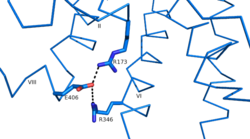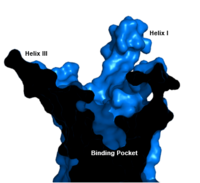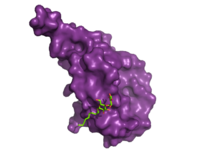Sandbox Reserved 1167
From Proteopedia
(Difference between revisions)
| Line 9: | Line 9: | ||
== Function == | == Function == | ||
| - | The glucagon receptor plays an important role in glucose homeostasis. During times of fasting (or low blood sugar) the pancreas produces glucagon to activate the GCGR in the liver. The [http://www.nature.com/nature/journal/v499/n7459/fig_tab/nature12393_F5.html binding of glucagon] | + | The glucagon receptor plays an important role in glucose homeostasis. During times of fasting (or low blood sugar) the pancreas produces glucagon to activate the GCGR in the liver. The [http://www.nature.com/nature/journal/v499/n7459/fig_tab/nature12393_F5.html binding of glucagon] to the extracellular side of GCGR leads to the activation of the receptor. On the intracellular side, upon this activation, a guanine diphosphate (GDP) is exchanged for a guanine triphosphate (GTP) - which, in turn, activates adenylate cyclase. Converting adenosine triphosphate (ATP) into cyclic adenosine monophosphate (cAMP), adenylate cyclase initiates protein kinase A (PKA) activity, which releases glucose into the blood stream. Overall, activation of the GCGR elevates blood sugar levels. |
Revision as of 08:14, 19 April 2016
| This Sandbox is Reserved from Jan 11 through August 12, 2016 for use in the course CH462 Central Metabolism taught by R. Jeremy Johnson at the Butler University, Indianapolis, USA. This reservation includes Sandbox Reserved 1160 through Sandbox Reserved 1184. |
To get started:
More help: Help:Editing |
Class B Human Glucagon G-Protein Coupled Receptor
References
- ↑ 1.0 1.1 1.2 1.3 1.4 1.5 Siu FY, He M, de Graaf C, Han GW, Yang D, Zhang Z, Zhou C, Xu Q, Wacker D, Joseph JS, Liu W, Lau J, Cherezov V, Katritch V, Wang MW, Stevens RC. Structure of the human glucagon class B G-protein-coupled receptor. Nature. 2013 Jul 25;499(7459):444-9. doi: 10.1038/nature12393. Epub 2013 Jul 17. PMID:23863937 doi:10.1038/nature12393
- ↑ 2.0 2.1 2.2 Hollenstein K, de Graaf C, Bortolato A, Wang MW, Marshall FH, Stevens RC. Insights into the structure of class B GPCRs. Trends Pharmacol Sci. 2014 Jan;35(1):12-22. doi: 10.1016/j.tips.2013.11.001. Epub, 2013 Dec 18. PMID:24359917 doi:http://dx.doi.org/10.1016/j.tips.2013.11.001
- ↑ 3.0 3.1 Yang L, Yang D, de Graaf C, Moeller A, West GM, Dharmarajan V, Wang C, Siu FY, Song G, Reedtz-Runge S, Pascal BD, Wu B, Potter CS, Zhou H, Griffin PR, Carragher B, Yang H, Wang MW, Stevens RC, Jiang H. Conformational states of the full-length glucagon receptor. Nat Commun. 2015 Jul 31;6:7859. doi: 10.1038/ncomms8859. PMID:26227798 doi:http://dx.doi.org/10.1038/ncomms8859
- ↑ 4.0 4.1 Koth CM, Murray JM, Mukund S, Madjidi A, Minn A, Clarke HJ, Wong T, Chiang V, Luis E, Estevez A, Rondon J, Zhang Y, Hotzel I, Allan BB. Molecular basis for negative regulation of the glucagon receptor. Proc Natl Acad Sci U S A. 2012 Sep 4;109(36):14393-8. Epub 2012 Aug 20. PMID:22908259 doi:http://dx.doi.org/10.1073/pnas.1206734109
- ↑ Mukund S, Shang Y, Clarke HJ, Madjidi A, Corn JE, Kates L, Kolumam G, Chiang V, Luis E, Murray J, Zhang Y, Hotzel I, Koth CM, Allan BB. Inhibitory mechanism of an allosteric antibody targeting the glucagon receptor. J Biol Chem. 2013 Nov 4. PMID:24189067 doi:http://dx.doi.org/10.1074/jbc.M113.496984
- ↑ Mittermayer F, Caveney E, De Oliveira C, Gourgiotis L, Puri M, Tai LJ, Turner JR. Addressing unmet medical needs in type 2 diabetes: a narrative review of drugs under development. Curr Diabetes Rev. 2015;11(1):17-31. doi: 10.2174/1573399810666141224121927. PMID:25537454 doi:http://dx.doi.org/10.2174/1573399810666141224121927



